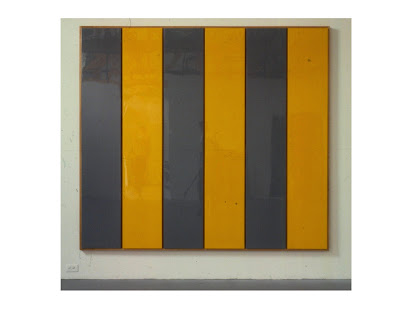
Tim Ebner’s paintings from the 1980s are to a large degree about production. The objects, more often than not, are multiple—made in bulk—and not unique; and they are made not from antiquated materials like oil paint but from prosaic industrial ones—acrylic, resin, fiberglass, zolatone. They have been stamped by their labor with a traditional morality and a humbleness—they result from an “honest day’s work.” Their brand of honesty lies in the straightforward, no-nonsense approach and in their wanting to be like everything else, plain and popular.
But more labor has gone into them than could ever be read back out as content. Within the mythology of Work—in which much modern painting enthusiastically participates, and into which Ebner’s paintings fall, backwards and shadowlike—this is profanity. Work is never misleading, never obscure. Just the opposite—it is always clear and affirmative, fully accountable and wholly self-evident. No matter if the labor is fully disciplined as in Seurat or Mondrian—painting as knowledge, as technique “perfected into a science” – or if it is undisciplined, as in Pollock or Kline—a passionate outburst, which reads as liberation and freedom, a “working beyond” restrictive conventions—work is always active and progressive and, above all, it is economical. The same goes for painting as it does for industry: minimum input should result in maximum visibility. From this kind of work comes material fact, positive values, and “good” meaning. And what gets eliminated in the process is everything that is wasteful and counterproductive: exotica, indirect reference, allusion, literariness, all the refuse marking a decadent art.
And yet, despite all the effort that’s gone into them, Ebner’s paintings lack any of work’s positive qualities. They have gone far beyond being things worked-over to become instead things overworked. In his paintings from the mid-‘80’s, such as the canvas above, Ebner used a wax-resist process to produce images of brushstrokes that weren’t actually there. Over the course of the '80s his paintings grew increasingly resined and lacquered, recalling more what Roland Barthes once said of plastic, that it is “in essence the stuff of alchemy…less a thing than the trace of a movement.” Work does not leave its mark, does not declare itself in Ebner’s paintings—rather, it gets absorbed. Seen in an endless array of guises, chameleonlike and ultimately unknowable, Ebner’s image of work sheds its ethical overtones to become something much more akin to a Symbolist motif—at times ghostly, at time impenetrable, its is always sensational and exotic, perverse and mesmerizing.

In his very last paintings of the '80s he refined this stunt, cutting down its long, drawn-out gymnastics. Ebner just buffed. Buffing became his new mystery—an invisible labor, a job that aims at its own erasure, that is complete only when it can no longer be detected.

Here's another artwork, by Ned Sokolov, that could be said to deal with labor. Sokolov hired two people, a woman and a man, to paint and repaint the gallery every hour of every day that his show was open. Both moving clockwise, always spaced about half the room apart, she painted the walls white, and he painted the walls black.

3 comments:
Tim Ebner reminds me of Jasper Johns. Like Ebner's, Johns' process is a tedious one. His work often involves encaustic painting, a method in which one paints with hot, pigmented wax. The end product doesn't always reflect this hard labor; we are left with intricate paintings like "Flag" that conceal their process and labor behind bold colors and cultural symbols. Like Ebner's, Johns' work can become "impenetrable." However, it is in their implicit labor that the works of both artists become most effective. As I believe we discussed in the 270 course, Johns' piece becomes disconcerting when we know how much labor was involved in rendering a cultural icon like the flag. The implied but invisible labor of Ebner's pieces also becomes disconcerting. It suggests that art is becoming as anonymous as the industrial, mass-produced public sphere it enters.
I agree with Lauren that there are parallels with Johns. Like Johns, he incorporates a range of concerns and stylistic influences into his pieces, including minimalism, abstract expresionism, color field, photography (in that what we see is the negative of the process, akin to a photographic negative), and process art.
When we first talked about Ebner's work in class I jotted down his name and went home to look him up right away. When i took basic paint with Dan Devening a few years ago we talked extensively about the way that paint gets on the canvas and how we can alter that process to add another layer to the piece. So this idea has been marinating in me for a while...
My friend and I have the same argument very frequently, where we argue about whether or not it is appropriate for an artist to expect the viewer to understand some background on them or the piece. knowing some history of an artist and their work can be critical to understanding the idea of the piece, but for an artist to rely on context is somewhat unfair; they can't reasonably expect everyone to read up on their entire biography before going to the gallery.
Ebner's technique though, is clearly essential to understanding his work. how much can the viewer be expected to understand outside of the experience of the piece? this really ends up being a comment on the class system and the intended audience...which is somewhat humorous, or ironic at least, considering the subject matter of this piece.
Post a Comment